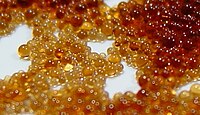
Photo from wikipedia
In this study, the removal of nine emerging organic contaminants was investigated by using anion exchange resins. The selected compounds were carbamazepine, atrazine, simazine, estrone, bisphenol A, methylparaben, ethylparaben, propylparaben… Click to show full abstract
In this study, the removal of nine emerging organic contaminants was investigated by using anion exchange resins. The selected compounds were carbamazepine, atrazine, simazine, estrone, bisphenol A, methylparaben, ethylparaben, propylparaben and butylparaben. Two different magnetic anionic exchanger resins were tested: MIEX® DOC and MIEX® GOLD. The optimal resin dose (40 mL/L) and contact time (20 min) had been previously determined. Once these optimum parameters were set, the effect of the initial concentration of contaminants on the removal efficiency of the contaminants by the resins was studied. The study was carried out using mono and multicomponent systems, with distilled water and natural waters, to which contaminants had been previously added, in order to evaluate the competitive and matrix effects. Results showed that the average removal percentages obtained with the MIEX® DOC resin were: 51%, 61%, 68% and 80% for methyl-, ethyl-, propyl-, and butylparaben, respectively. For bisphenol A the result was similar, i.e., 66%, whereas for the rest of the compounds studied, removal efficiencies lower than 15% were obtained. The MIEX® GOLD resin achieved lower elimination rates than the MIEX® DOC resin in all cases.
Journal Title: Chemosphere
Year Published: 2018
Link to full text (if available)
Share on Social Media: Sign Up to like & get
recommendations!